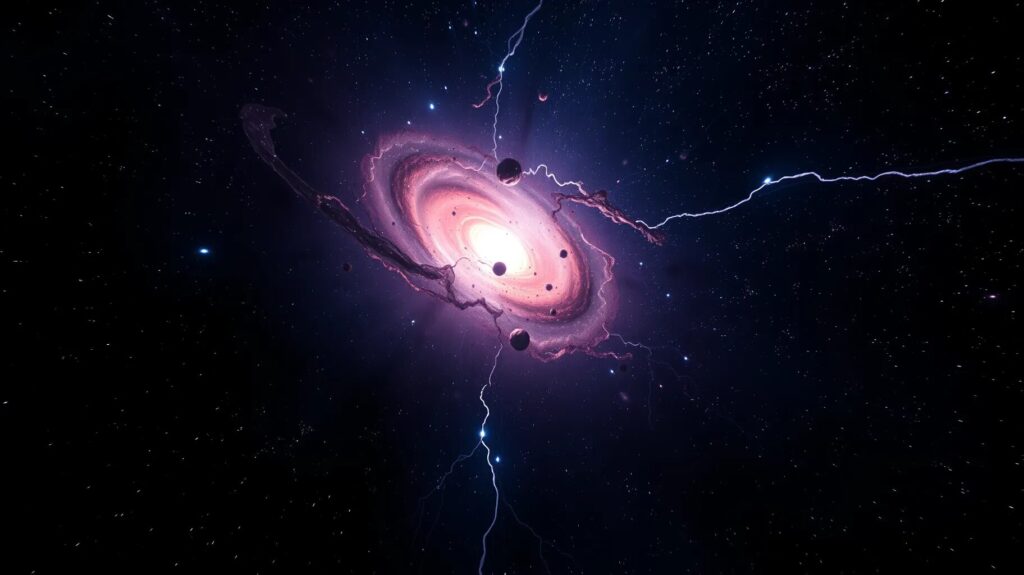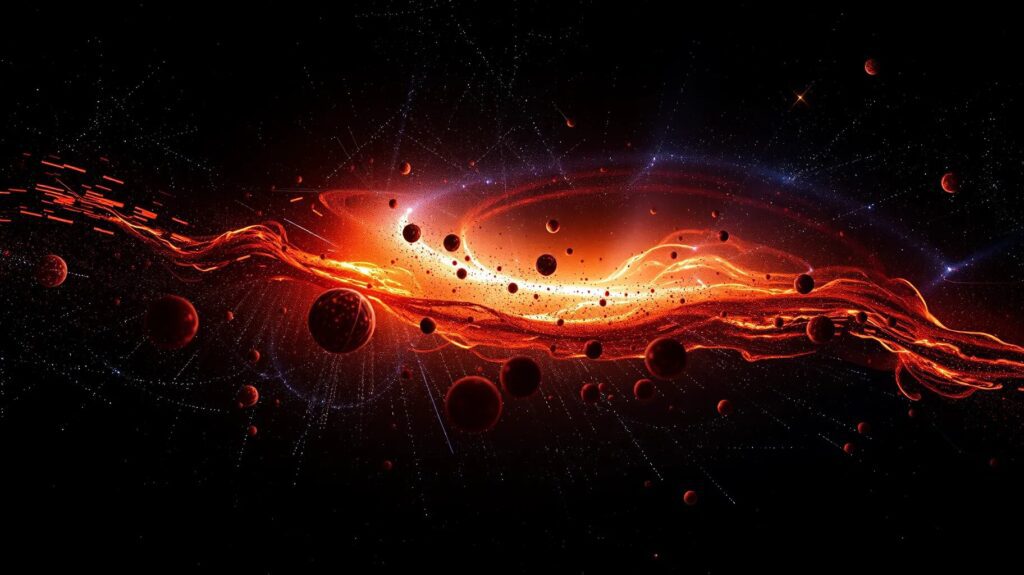
The Elusive Nature of Dark Matter
Dark matter. Just hearing the term feels mysterious, almost like peering into a cosmic black box. We know it’s there—it makes up a staggering 85% of the universe’s total mass—but we can’t see it, touch it, or directly observe it. Scientists have spent decades attempting to understand what makes up this unseen material, yet its nature continues to baffle even the brightest minds in physics. It’s like a riddle that’s been woven into the very fabric of our cosmos, lurking in the background, yet essential to everything we know about the universe. Without it, galaxies wouldn’t form, stars wouldn’t cluster, and the universe as we know it might not even exist.
Enter AI: A New Frontier in Physics
With AI breaking new ground in virtually every field, from art to medicine, it was only a matter of time before it entered the realm of theoretical physics. What’s fascinating is how this once purely computational tool is now being applied to crack some of the biggest mysteries of the cosmos. Using AI’s incredible ability to process enormous amounts of data, scientists are hoping to detect the invisible—or rather, what we haven’t yet been able to detect with our traditional methods.
Machine learning algorithms have been tuned to recognize patterns that human eyes would easily miss. AI’s capacity to “learn” and improve with each new data point is proving to be a huge advantage when it comes to the nearly insurmountable challenge of identifying something as elusive as dark matter. When physicists joined forces with AI experts, the collaboration became a game-changer, propelling dark matter research into new, exciting territories.
What is the “Ghost Particle”?
The so-called “ghost particle”, known more formally as a hypothetical sterile neutrino, is one of the most promising candidates for dark matter. Unlike the familiar particles that make up ordinary matter, such as protons and neutrons, these particles are thought to interact only through gravity and possibly the weak force, making them exceptionally difficult to detect. They’re like cosmic specters—always there, but almost never leaving a trace. This is where AI comes into the picture.
By analyzing massive datasets from particle detectors, AI has helped uncover subtle signals that might indicate the presence of these elusive sterile neutrinos. It’s as if AI is peeling back layers of cosmic noise, revealing tiny clues that could finally point us to the ghost particle itself. But how does it manage to do this, and why are scientists so excited?
Dark Matter’s Role in the Universe
Before we dive deeper into AI’s contribution, it’s crucial to understand why dark matter is such a big deal. Imagine a galaxy spinning in space. Based on everything we know about gravitational pull, galaxies should be flying apart, with stars careening into the void. Yet, they stay intact, as if some invisible hand is holding them together. That “hand” is dark matter. Its gravity is strong enough to keep galaxies glued together, despite what visible matter would suggest.
Dark matter is also essential in cosmic events like gravitational lensing, where light from distant galaxies bends around invisible masses, giving scientists indirect evidence of its existence. So, even though we can’t directly observe dark matter, its fingerprints are all over the universe, leaving scientists itching to find out exactly what it is.
AI’s Revolutionary Approach to Particle Detection
Traditional methods of searching for dark matter have involved sifting through massive amounts of data from particle collisions or astronomical observations. This is an uphill battle, given that the data is often noisy and the signals of dark matter particles, like the ghost particle, are incredibly faint. AI, however, has the ability to “see” beyond the noise.
Through deep learning algorithms, AI can analyze intricate patterns in the data, identifying what might be a signature of a ghost particle amidst billions of other possibilities. It’s like trying to find a needle in a haystack, but with a machine that can sift through the hay at the speed of light! This ability to rapidly process and learn from data is what sets AI apart, offering a fresh approach that many believe will lead to breakthroughs in dark matter detection soon.
How AI Uncovers Patterns in Data
The genius of AI lies in its ability to find patterns that the human brain simply cannot spot. When it comes to particle detection, the data generated is staggeringly complex. Think of it as looking for whispers in a room full of shouting. In this case, AI serves as an expert eavesdropper, focusing on the faint signals and discarding irrelevant noise.
Machine learning models are trained using a combination of simulated data and real-world inputs from experiments like CERN’s Large Hadron Collider (LHC). With each new batch of data, these models become more adept at identifying weak signals, potentially linked to the mysterious ghost particle. Instead of traditional brute-force techniques, AI can learn from the data, adapt its methods, and become increasingly efficient over time. What used to take years of manual analysis can now be done in a fraction of the time.
The Search for Dark Matter: Past and Present

Historically, the search for dark matter has been a long and winding journey. Physicists have tried everything from direct detection methods—using giant underground detectors—to astrophysical observations. Yet, the evasive nature of dark matter particles has left them grasping at straws. Theories have come and gone, and countless experiments have produced null results.
Today, with AI’s help, the tide seems to be turning. We’re no longer limited to traditional methods. AI can work around the clock, analyzing data at speeds humans could only dream of. By integrating machine learning into current particle physics research, we’re seeing fresh possibilities open up. It’s as if AI is casting a wider net, catching things that slipped through in earlier searches. This integration signals a new era, where machines assist in what might otherwise feel like an impossible task.
Machine Learning in Modern Physics
It’s almost mind-boggling to think about how machine learning has transformed modern physics. In many ways, AI is now the physicist’s most powerful tool. Where human intuition falters, machine learning shines by following the data, rather than preconceived theories. It provides physicists with a new lens to look through—a way to interpret results with speed and precision.
For example, AI can be fed historical data from past dark matter experiments, refining its ability to predict where and how signals might appear in future experiments. Not only does this drastically cut down the time it takes to make discoveries, but it also means scientists can explore ideas that once seemed too speculative. Machine learning brings a unique, data-driven rigor to the table, one that compliments human ingenuity with computational strength.
Quantum Mechanics Meets Artificial Intelligence
Quantum mechanics and AI might seem like an odd pair, but when it comes to dark matter research, they’re an unstoppable force. Quantum mechanics, with its probabilistic nature, has always been tough to understand fully. The complex interactions of particles, especially those that exist only in theory, often elude even the most sophisticated models.
AI, however, thrives in this chaos. Using quantum-inspired algorithms, AI helps unravel the puzzles of quantum mechanics in ways that were once beyond reach. Imagine trying to calculate the behavior of a single dark matter particle within the grand scheme of the universe. AI, working with quantum models, can make sense of these seemingly random events, offering scientists a new path to explore the ghost particle phenomenon.
The Implications of Ghost Particle Detection
Detecting the ghost particle—or confirming its existence—would fundamentally change our understanding of the universe. It would be the first direct proof of dark matter, answering questions physicists have puzzled over for decades. But the implications stretch beyond scientific curiosity. Identifying dark matter would reshape models of the cosmos, from the birth of stars to the expansion of galaxies.
We’re talking about redefining physics as we know it. Everything from how we understand the Big Bang to the formation of black holes could be reevaluated with new data derived from detecting this ghostly particle. With AI driving the search, the chances of achieving this once-unfathomable discovery seem closer than ever before.
Could AI Solve Other Mysteries of the Universe?

While AI is making groundbreaking strides in dark matter research, its potential stretches far beyond just the ghost particle. AI’s ability to process enormous datasets and uncover hidden patterns means it could help solve other cosmic puzzles. For instance, what if AI could reveal insights into dark energy, the mysterious force responsible for the universe’s accelerated expansion? Or perhaps it could help us understand the true nature of black holes, which continue to baffle astrophysicists.
One of the most intriguing possibilities is AI’s role in the ongoing search for extraterrestrial life. With its capacity to sift through vast amounts of data from radio telescopes or space missions like Kepler, AI could spot anomalies or signals that might indicate the presence of life on distant planets. In short, we’re only scratching the surface of what AI can uncover about our universe.
A Collaborative Effort: Humans and Machines
Though AI plays an increasingly prominent role in dark matter and other physics research, it’s important to remember that human intuition still plays a vital role. AI can crunch numbers and detect patterns, but the creativity and insight that come from scientists are irreplaceable. In fact, the collaboration between human minds and artificial intelligence often leads to the most successful outcomes.
Researchers guide the AI by asking the right questions and framing experiments, while AI provides the computational power and pattern recognition necessary to answer them. This symbiosis of human and machine is what’s driving modern physics forward at a pace we’ve never seen before. It’s a beautiful example of how technology doesn’t replace scientists—it empowers them to explore further, to dig deeper.
The Future of Dark Matter Research
The next decade in dark matter research promises to be one of the most exciting in recent history. As AI continues to evolve and refine its models, physicists will gain unprecedented access to deeper insights into the universe. We might be on the cusp of identifying dark matter’s true nature, with the ghost particle leading the way. But beyond just detection, we may also discover how dark matter interacts with ordinary matter and what role it plays in the grand evolution of the cosmos.
The stakes are high. Cracking the dark matter code could lead to breakthroughs in energy, technology, and our overall understanding of fundamental physics. AI will undoubtedly be at the forefront of these discoveries, pushing boundaries and opening new doors in scientific exploration.
Ethical Considerations in AI-Driven Discoveries
While the rise of AI in scientific research is thrilling, it also raises important ethical questions. As we rely more heavily on machines to guide our discoveries, how do we ensure that the data they analyze is unbiased or that the interpretations are accurate? AI isn’t infallible—it learns from data, and if that data is incomplete or flawed, the outcomes could be misleading. Ensuring that human oversight remains an integral part of the process is key to avoiding pitfalls.
Another concern revolves around the accessibility of this technology. Will AI-driven discoveries benefit all of humanity, or will they be reserved for elite institutions or nations with access to cutting-edge technology? These questions will need to be addressed as AI continues to shape the future of cosmic research.
Challenges in Dark Matter Exploration
Despite AI’s impressive abilities, the search for dark matter is still filled with challenges. The biggest hurdle? We’re working with the unknown. No one knows exactly what dark matter is, what it’s made of, or how it interacts with other forces and particles. Even with AI’s ability to detect faint signals, we’re still dealing with probabilities, guesses, and theories.
There’s also the issue of data quality. Dark matter experiments generate enormous volumes of information, but much of it is “noise”—irrelevant data that can cloud the results. AI helps filter through this, but its predictions are only as good as the data it’s fed. So far, the ghost particle remains a hypothesis, and until we have direct evidence, it will remain in the realm of the unknown.
And then, of course, there’s the financial cost. Cutting-edge research like this requires substantial funding, which can be difficult to secure consistently. The challenges, however, are part of what makes the journey exciting—AI or no AI, the mystery of dark matter is one of the greatest puzzles in modern science.
How AI Will Shape the Next Generation of Physicists
As AI continues to transform how we approach scientific problems, the next generation of physicists will need to adapt. Gone are the days when a physicist could rely solely on traditional methods. The future physicist will need to be fluent in data science, comfortable working alongside machine learning algorithms, and capable of collaborating with experts from fields like computer science and engineering.
AI will become a core part of a physicist’s toolkit, much like a calculator or telescope once was. But more than that, it will redefine what it means to conduct research. Hypothesis-driven science will increasingly be complemented by data-driven insights. Physicists will need to learn not just how to interpret results from AI but also how to steer the algorithms in the right direction, asking the kinds of questions that only human curiosity and imagination can inspire.
AI’s Role in Building Better Experiments
One often-overlooked aspect of AI’s contribution to dark matter research is its ability to design better experiments. Instead of running countless iterations and hoping for a breakthrough, AI can optimize the process from the start. By analyzing previous experiments, AI can predict which configurations are most likely to yield meaningful results.
For example, when building a new particle detector or planning an experiment to search for dark matter, AI can simulate multiple scenarios and tell scientists which setup has the highest probability of success. This could save years of trial and error and significant financial resources. Machine learning algorithms can even suggest novel approaches to experiments that human scientists might not have considered—pushing the boundaries of what’s possible in the search for the ghost particle.
Bridging the Gap Between Theory and Reality
One of the most exciting possibilities is that AI might help bridge the ever-widening gap between theoretical physics and experimental evidence. Theoretical physicists have long grappled with ideas that are difficult, if not impossible, to test directly. Take string theory, for example, or the multiverse hypothesis. These concepts are fascinating but notoriously challenging to prove through observation.
AI could help translate some of these lofty ideas into testable hypotheses. By recognizing patterns in both experimental and observational data, AI can guide physicists toward experiments that might offer indirect evidence of these theories. It’s an exciting thought: AI, in partnership with human creativity, could eventually help us test the boundaries of the universe’s most mind-bending theories.
The Human Element: Why We Still Need Human Curiosity
Despite the incredible advancements AI brings to the table, there’s something it can never replace: human curiosity. At its core, science is driven by wonder and the desire to understand the universe. Machines can process data and predict outcomes, but they don’t ponder the mysteries of existence or ask the kind of bold, imaginative questions that lead to paradigm-shifting discoveries.
Think about Einstein’s theory of relativity—it didn’t come from crunching numbers. It came from thought experiments and creative leaps. AI is a tool, albeit a revolutionary one, but the heart of discovery still lies in the hands of scientists who dare to question the status quo. As AI becomes a bigger part of dark matter research, the real breakthroughs will come from the synergy between machine efficiency and human ingenuity.
Wrapping Up the Quest for Dark Matter
The search for dark matter, and specifically the detection of the ghost particle, represents one of the most ambitious undertakings in modern science. With AI leading the charge, the possibility of cracking this cosmic mystery feels more tangible than ever. Yet, it’s important to remember that this journey is far from over. Every discovery opens the door to new questions, and as we uncover more about dark matter, the universe will undoubtedly reveal even deeper layers of complexity.
Physicists are stepping into a new age, armed with tools like AI that enhance their ability to explore the unknown. But it’s the collaboration between human intellect and artificial intelligence that will ultimately unlock the secrets of dark matter, transforming our understanding of the cosmos and our place within it.
Resources
1. CERN: Large Hadron Collider Experiments
- CERN’s website provides comprehensive information on the Large Hadron Collider (LHC) and its experiments, including efforts to detect dark matter particles.
- CERN’s LHC Experiments
2. NASA: Dark Matter and Dark Energy
- NASA offers detailed explanations of dark matter, dark energy, and their significance in understanding the universe’s structure.
- NASA Dark Matter Overview
3. Journal of High Energy Physics (JHEP)
- Leading journal publishing papers on particle physics, including those focused on AI applications in dark matter research.
- JHEP Journal
4. MIT Technology Review: AI and the Universe
- This publication often covers the intersection of AI and cosmic research, with articles exploring AI’s growing role in physics.
- MIT Technology Review
5. Fermilab: Dark Matter Research
- Fermilab is one of the key institutions involved in dark matter research. Their website provides updates on their experiments and breakthroughs.
- Fermilab’s Dark Matter Research
6. ScienceDirect: AI in Physics
- Access peer-reviewed articles that explore the use of machine learning and AI in theoretical and experimental physics.
- ScienceDirect
7. Physics World: AI in Particle Physics
- Physics World often publishes insights into how AI is transforming particle physics, including coverage of dark matter experiments.
- Physics World AI and Physics
8. The Royal Society: Artificial Intelligence in Scientific Research
- A resource hub for papers and discussions on how AI is being integrated into various scientific fields, including physics.
- The Royal Society





